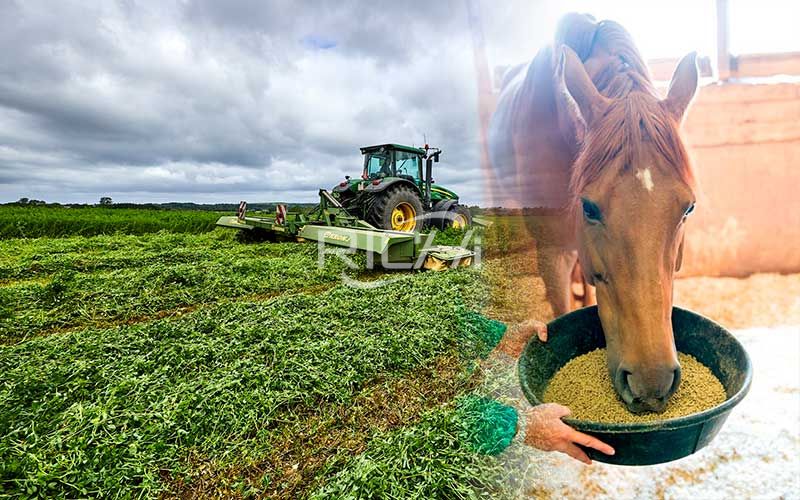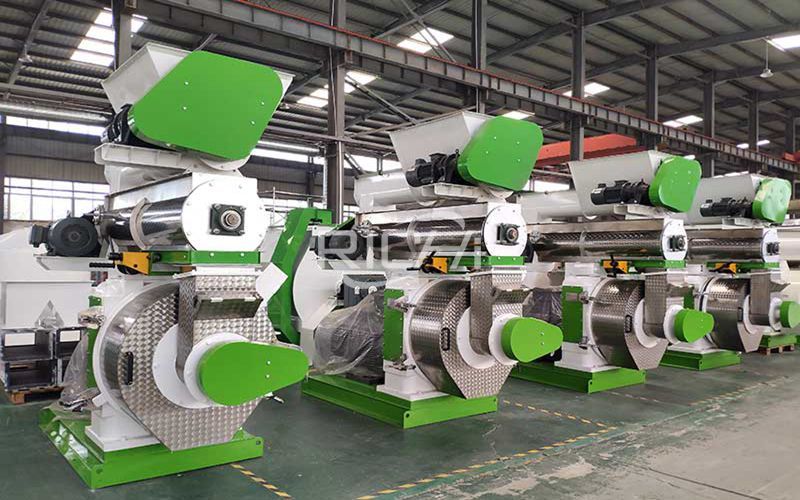
This is where you find all our press releases and news articles.

French Alfalfa Grown as High-protein Horse Feed
Also known as lucerne, alfalfa belongs to the Leguminosae family and has been used as a fodder feed for cattle and horses for centuries. The word alfalfa is mostly used in North America and parts of Europe but lucerne is more widely used in the UK, South Africa, Australia, and New Zealand. At first glance the plant looks a lot like clover with its three pronged leaf structure. It also has clusters of small purple flowers which are followed by fruits spiralled in two to three turns containing up to 20 seeds.
Many people know that alfalfa lucerne pellets are high-quality feed for cattle and horses, but do not know how alfalfa pellets are produced. First, the production of alfalfa pellets is not just a single grass/alfalfa pellet machine. He needs alfalfa Lucerne crusher, feed mixer, Lucerne pellet machine, cooling system and screening system. The alfalfa pellets produced by such a perfect alfalfa pellet production line equipment can be packaged or directly fed to cattle, sheep and horses.
France is one of the major producers of alfalfa and exports the crop after drying it, to a number of different countries, some of which are affected by hot temperatures and long spells of drought. France itself was also affected by drought for the past 2 years and as a result many farmers decided to grow alfalfa as the grass was not growing. Around 80% of the alfalfa in France is grown in the main farming region east of Paris but in all of France 10,000 farmers grow the crop for themselves or for various drying plants operated by co-ops.
In a good year up to 4 cuts of alfalfa can be taken annually with a yield of 14 tonnes per hectare from the first cut. That average yield falls with each cut that follows. One of the main advantages of alfalfa is that it contains 2,400kgs of protein per hectare which is much higher than soya at 1,000kgs to 1,500kgs of protein per hectare. Alfalfa gains its high content of nutrients and vitamins due to its deep root system that can extend to over 20 feet deep taking in nutrients unreachable by normal root systems. Managing the crop uses very few herbicides and in France it is all non-GMO. Around 7% of the total production is farmed organically and this figure is growing rapidly. Alfalfa is normally dried after harvesting to produce high quality bales or pellets for livestock. This year demand for bales across Europe was high due to the prolonged periods of drought. When the alfalfa is harvested the moisture content is around 65% so it is then sent to the dehydration plants to be dried in a rotary drying drum. Hot air currents at 150°C to 650°C generated by coal furnaces dry the crop to around 10% humidity before it is crushed to be made into pellets or sent uncrushed for baling.
Masset runs a 200 hectare farm of which 15% is used to grow alfalfa and the remainder for a variety of grain crops. He reports some of his grain yields fell this year due to the harsh drought period. “Our wheat yielded 9.5 tonnes per hectare this year, winter barley was 8.5 tonnes, rapeseed was around 3 tonnes and spring barley was 8 tonnes per hectare,” Masset said. “Normally the alfalfa would yield around 14 tonnes per hectare but this year being so dry the average yield was down to 10 tonnes per hectare. We harvested each cut after 45 days of growth. When the alfalfa is dried it can sell for € 170 per tonne for the pellets and € 190 per tonne for the bales which weigh around 380kgs to 440kgs each,” he added.
Luzeal exports around 60-70% of the bales it produces to the Benelux countries, Switzerland, Germany and into Saudi Arabia. Farmers that grow alfalfa in France receive a subsidy from the European Parliament of around € 10 per tonne. In total, French farmers grow in the region of 67,000 hectares of alfalfa each year and receive approximately € 8 million in subsidies for it. “The future for growing alfalfa in France is very good,” said Masset. “Over half the proteins required by livestock farmers in France are grown in France and alfalfa is a key component of that overall production. “As we saw this year with changing climates and a long drought period alfalfa was a vital crop to produce forage for not only French farmers, but those further afield also affected by dry or drought conditions. “There is obviously a big demand for alfalfa from dairy farmers due to the high nutrient value of the crop. However, there is a growing demand for alfalfa to feed horses as well. Alfalfa pellets are less dusty and are suitable for older horses that have problems with their teeth because the pellets require less chewing than hay,” he said.

Firstly, get your alfalfa pellet mill or pellet plant ready. If just for own use at home, a small pellet mill is enough. For a pellet plant, you can take a large scale machine and related equipment.
Secondly, prepare a dryer. As we all know, the wetter or dryer material will affect the final quality of biomass pellets, so you need a dryer to get the suitable moisture, which is always about 15%.
Thirdly, grinding alfalfa to get appropriate size for the alfalfa pellet machine.
Finally, put the alfalfa to the feeder of the alfalfa pellet mill.
Having the right mix of reliable, high-quality pellet machine and pelletizing systems and expert support is essential to your success. Watch how our end-to-end feed pellet plant solutions have helped our customers optimize their performance.
Our customized and future-proofed turnkey pellet plant solutions is designed with you at the core. From vision to reality and beyond, our team stays connected with yours. Giving you peace-of-mind with an expert at your side.

At RICHI, we go beyond project completion. With RICHI Servicee, we’re your dedicated partners in success. Count on us for expert guidance, minimal downtime, and optimized productivity. Choose RICHI for unmatched service and support.



Meet global product demands and quality standards with industry-leading pellet plant design, engineering, equipment, and construction services for pellet processors.


Your Partner Beyond Project Completion
2000+ cases
RICHI is the leading designer, manufacturer and builder of pellet plants in the world, completing over 2000 projects in 140 countries across 6 continents.
Read More
Increase plant productivity, profitability, and safety by integrating high quality equipment into your pellet production line. Over the years, RICHI has become China's top pellet equipment manufacturer. At the same time, RICHI has established valuable partnerships with the world's leading component and raw material manufacturers to bring you the best there is in technology, automation, and efficiency in pelleting plant machinery.

For nearly 30 years, RICHI has been providing best-in-class pellet plant equipment and services to clients across a variety of industries, sizes, and needs. We pride ourselves on the knowledge and skill that each team member possesses – from our technical sales team to our process design engineers. You can count on RICHI Machinery to take your operation to the next level of innovation, quality, and success.
Need help with your pellet manufacturing plant project? Contact us today.
ANIMAL FEED
BIOMASS
WOOD
ORGANIC FERTILIZER
AQUA FEED
CAT LITTER
MUNICIPAL WASTE RECYCLING
SPECIAL PELLET PRODUCTION
RICHI Machinery continues to deliver world class pellet mill equipment, pellet plant engineering and project solutions that add value to our customers in the animal feed, wood waste, agriculture waste, organic fertilizer, cat litter and special pellet products industries. Throughout the years, we RICHI Machinery have built strong brand, becoming industry-leading pellet machine manufacturer. We value integrity, promise quality, and prioritize your success.
Learn MoreWith our expert team, we precisely implement your process engineering requirements in pellet mill and pelletizing plant systems. No matter which industry you’re in – we understand your needs and deliver solutions that meet the highest standards.
At RICHI, quality comes first. Our pellet making machine and related pellet line equipment undergo rigorous quality controls to ensure they meet the highest standards. Rely on products that are durable, safe, and efficient.
With decades of experience in pellet machine and pellet production line production, we have earned a reputation as a trusted partner in various industries. Our expertise allows us to cover a wide range of applications.
Not only do we offer premium pelleting equipment, but we are also experts at designing, building, installing, and maintaining facilities from the ground up. Our expertise is within pellt plant process design, discovering the most efficient, productive, and profitable way to handle your materials in an end-to-end cycle.

Keeping in touch with us is an effective way to solve all your problems. If you have any needs or questions, please leave your contact information, then RICHI technical consultants will send design, quotation, videos to your mailbox. You can also contact us directly via WhatsApp: +86 13838389622
Copyright©2015-2024 by HENAN RICHI MACHINERY CO., LTD. All rights reserved.